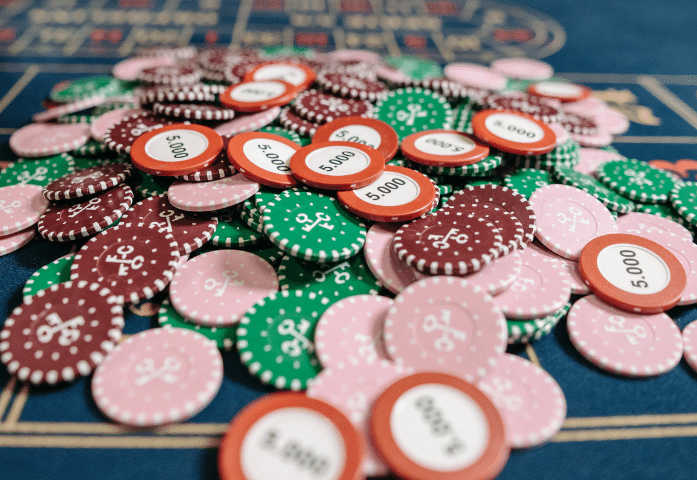September 17, 2021
The History of Baccarat

Think baccarat is only for James Bond and high rollers? Think again. Learn about the history of this intriguing casino game, and then give it a try!
Baccarat is an intriguing game. It’s simple enough in general theory, but it’s a bit more complex than it looks when it comes to when to draw and when to stand.
But if you’re playing American baccarat, you won’t even have to worry about this because:
- The dealer is the only person who has to handle the cards and draw or stand accordingly.
- If you want to follow along, plenty of casinos offer printed-out rules so you can see why the dealer drew or stood on that particular hand.
So while baccarat is a simple enough game to bet on, trying to pin down its exact history is a rather different process. Even the roots of its name aren’t clear-cut. How did this game develop into the game it is today, with all of its associations with rich gamblers and even James Bond?
The Etruscan Legend
Allegedly, the game took its inspiration from an ancient Etruscan tale involving nine gods. These were most likely the nine gods that the Romans referred to as Novensiles, who had the power to hurl thunderbolts. In this tale, the gods were apparently deeply involved in the fate of a particular virgin woman. She had to throw a nine-sided die to determine her future.
If she rolled an 8 or a 9, she would be elevated to the status of a priestess. If she rolled a 6 or a 7, she could live but would be banned from any future religious events in her community. If she rolled a 5 or lower, she would be banished to the sea to drown.
This might have been the lore behind an ancient Roman dice game where you won if you rolled an 8 or a 9.
Starting in Italy … Maybe?
Fast-forward a couple of millennia, and we’re in Italy in the 1400s. This is when a man who was named either Felix Falguiere or Felix Falguierein reputedly invented the game of baccarat, and the stories say that he was inspired by the Etruscan fable.
Other people assert that Felix was influenced by games like Le Her and Macao.
In Le Her, the dealer gives one card to themselves and to a player. The player may choose to exchange their card with the dealer, and the dealer may choose to exchange their card with the top card from the deck. Whoever has the higher-ranked card wins.
This sounds like a solid potential influence, until you realize that Le Her apparently only dates back to the 1500s, and Felix was said to have invented baccarat in the 1400s.
Meanwhile, in Macao, the cards are scored the same way as they are in baccarat (aces are 1, 10s and face cards are 0, and the remaining cards are worth their pip value). The goal is to get as close to 9 points with as few cards as possible, but in Macao it is possible to bust by going over 9.
Some people believe that Macao is a forerunner of baccarat, but the timing also seems off here. Apparently Macao was first mentioned in 1783, and we’re still looking at the 1400s as the timeframe of when baccarat was potentially invented by Felix.
No matter the supposed influences, the initial version of baccarat was played a bit differently than we think of it today. First off, it was played with tarot cards rather than a 52-card deck. The cards were dealt out by four different dealers. Each player had a chance to play as the Banker, and players could even place bets against each other, as well as against the house.
And let’s share a quick lesson on language. Plenty of webpages out there say that the name of the game comes from the Italian word “baccara,” which supposedly means “zero,” but this is not the case — the word for that number is still “zero” in Italian. One possibility exists that the name came from some Venetian slang, but that’s going to be hard to confirm.
The Move to France
During and after the Italian Wars of the late 15th century, French soldiers returning home from the campaigns allegedly brought the game of baccarat back with them. It was apparently a big hit with the French nobility, and French variations on baccarat quickly spread (namely, Chemin de Fer and Baccarat Banque).
England Takes It Up a Notch
By the 1800s, baccarat and its French variants had made their way across Europe and into the U.K. From there, England has two major contributions to the complex story of baccarat.
The Royal Baccarat Scandal
Baccarat became quite the hot topic in 1891 when it was at the center of a royal scandal.
Sir William Gordon-Cumming, a friend of the then-Prince of Wales (and future King Edward VII), was accused of cheating at baccarat during a party at the house of Arthur Wilson. Members of the Wilson family saw Gordon-Cumming acting suspiciously and possibly illegally adding to his stake, so they eventually confronted him and made him sign a document that declared he would never play cards again, in exchange for the Wilson family’s silence about the matter.
Gordon-Cumming later demanded a retraction from the Wilsons. When they refused, he accused them of slander. In court, even Prince Edward himself was called as a witness, and it was all a big theatrical hullabaloo. Eventually, the jury found against Gordon-Cumming. He was socially ostracized, and even the prince was quite unpopular in the public opinion for years after the trial.
Bond … James Bond
In 1953, former British spy Ian Fleming published his debut novel, Casino Royale, and the world was introduced to the character of James Bond. In the book, Bond faces off against SMERSH agent Le Chiffre at the casino in Royale-les-Eaux in a cutthroat game of baccarat.
Interestingly enough, baccarat still wasn’t that popular of a casino game in England, even though Fleming himself loved the game and was overall quite the gambler. Some sources say that the first edition of the book included a basic tutorial on how to play baccarat so that readers could understand the finer details of the big baccarat game. Even if there was no separate instruction guide offered in the text, the book itself has Bond detail the rules of the game to Vesper Lynd over dinner before the inevitable showdown over the baccarat table.
Coming to the Americas
A version of baccarat had apparently been brought to Argentina at one point, where it was called Punto y Banco (Player and Banker). When it made its way to Cuba, the rules evolved somewhat, and it became known as just Punto Banco. This is the version we all generally think of as American baccarat, including the feature of players betting against the house instead of each other.
During the political upheavals in 1950s Cuba, a manager at the Capri Hotel Casino in Havana had the idea to try to move up to Las Vegas and bring the game of Punto Banco with him. This man, Frances “Tommy” Renzoni, introduced the game at the Sands Hotel in Vegas, and the hotel went all in on premiering Punto Banco as a major event. The Sands had created a roped-off pit area for the baccarat tables, giving the whole thing an air of exclusivity.
Baccarat (or Punto Banco, in this case) never really caught on with American audiences on the same level as games like poker or blackjack. By the 1970s, there were still only 15 Punto Banco tables on the entire Vegas strip. To try to justify these low numbers, casinos marketed the game as glamorous and dripping with opulence. Casinos started putting their baccarat tables in private rooms set off with velvet curtains, sat the players in expensive leather chairs, and set exorbitant minimum bets to attract only the highest of high rollers.
Explosion in Asia
If you’re playing baccarat in an American casino, especially at a smaller table like you would see in mini baccarat, you’ll most likely note some Chinese elements in the table design. There’s a big reason why, and it all starts in Macau.
Why Macau?
In Macau, gambling has been legal since the 1850s, back when it was a Portuguese colony. Gambling houses were a source of revenue for the Portuguese government, and in 1962, the government gave monopoly casino rights to a syndicate formed by Macau and Hong Kong businessmen. This syndicate brought in Western-style games and generally expanded Macau’s gambling reach to visitors from Hong Kong.
In 1999, Macau was transferred to China, and in 2002 the Macau government ended the monopoly system, which opened the doors to so many more international casinos that wanted to join the playing field. In fact, as of 2019, there were 41 casinos within its borders.
Currently, gambling tourism makes up about half of Macau’s economy. Macau is considered by many to be the Monte Carlo of the East, and even the Gambling Capital of the World. It is also the only place in Greater China where gambling is legal, so it’s a destination for many rich Chinese nationals who wish to flash their money and try their luck.
And baccarat, with its globally influenced sense of exclusivity, was a big draw for Chinese high rollers. It helped baccarat blow up in popularity to the point where, according to some sources, baccarat makes up around 90% of Macau casinos’ annual revenues.
Chinese Superstition and Baccarat
Baccarat is an easy game to play, based strictly on chance. Many Chinese players may come to the table feeling like their luck is placed directly in the shoe, and so they’ll do what they can to try to increase their luck however possible. This has eventually led to baccarat tables themselves getting a bit of a Chinese overhaul.
If you’re playing in Macau, Singapore, or even the U.S., you’ll most likely see that the seat numbers on the table skip the number 4 and instead have the seventh spot be numbered 8.
This is because the Chinese word for “four” (四 – sì) sounds similar to the word for “death” (死亡 – sǐwáng), and a seat with that number would never have someone sitting there, cutting down on the table’s potential profits.
Instead, the last seat is numbered 8 because the Chinese word for “eight” (八 – bā) sounds similar to the phrase “to get rich” (发财 – facai). Plus, if the Banker or the Player has an 8, that’s a pretty great hand already in the rules of baccarat, and now it’s even more meaningful if you’re Chinese and playing the game.
To cater to the vast swath of Chinese players who travel globally, baccarat table manufacturers have embraced these superstitions and incorporated such Chinese influences.
The Transition to Online Baccarat
Thanks to the internet, the 1990s saw gambling reach new heights because of the sudden digital access to casinos. The first online casino got its start in 1996 with slot machines and blackjack, and more games became available as time went on.
Now, players were no longer limited to their personal geography. If they didn’t live close to a physical casino, they could still enjoy the thrill of gambling from home. Today, if you live in states like Pennsylvania, New Jersey, or West Virginia, you have the ability to gamble online at your state-licensed online casinos.
And the gambling software uses random number generators to mimic the randomness of pulling shuffled cards from a shoe. This means that the house won’t have an unfair advantage by choosing the same cards repeatedly, but it also means that players can’t cheat by finding any patterns in the results. No matter where or how you play it, baccarat has remained a genuinely random game.
And for the people who still want a little human interaction, there are live dealer options at many online casinos. Rather than having digital cards flip up on your screen, you get to watch as a dealer is live-streamed to your device. Your chips are all digital, but the cards are real. You can even type out messages to the dealer, and they’ll get to respond to you in real time. Live dealer baccarat is truly the best of both worlds: getting the real casino experience while still sitting in your sweatpants on the couch.
Baccarat Today
It may not be the most popular game in the U.S. but baccarat is still a very iconic casino game. Casinos the world over invite high rollers to try their luck at the tables, and those high rollers are willing to keep up that posh reputation.
On the other end, plenty of American casinos let you still play baccarat with minimum bets as low as $25 or even $10 if you’re lucky. And in online casinos, you can make bets as low as $1. So it’s not some stuffy game reserved only for people in gowns and tuxedos — baccarat can truly be for anyone.
So really, does baccarat’s convoluted, questionable written history really matter? Probably not. The type of baccarat that people play today is so different from how it allegedly got its start, so knowing this history is probably better for trivia night at the local bar than helping you understand how to appreciate the game.
And what a game it is. Whether you prefer to play in a live casino or online, baccarat is definitely here to stay.



